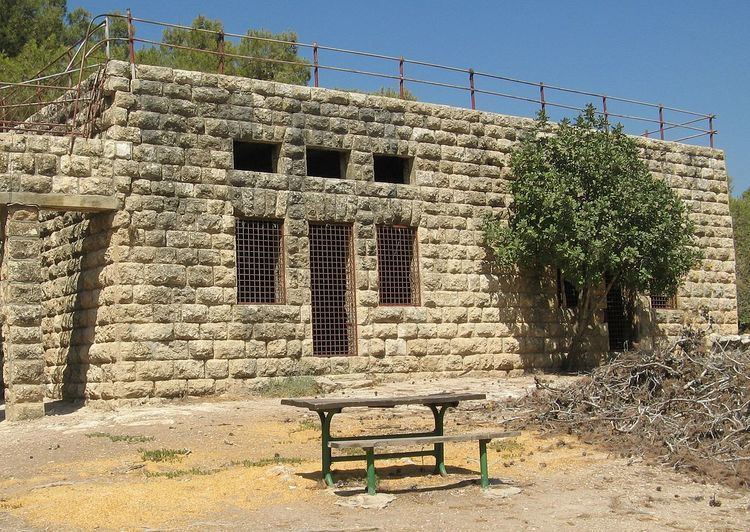Arabic بيت جيز Area 8,357 dunams8.4 km² Date of depopulation 20 April 1948 | Also spelled Beit Jiz Palestine grid 145/135 Local time Tuesday 11:07 PM | |
 | ||
Name meaning The ruin of the house of the valley side Weather 21°C, Wind E at 18 km/h, 33% Humidity Current localities | ||
Bayt Jiz (Arabic: بيت جيز) was a Palestinian Arab village situated on undulating land in the western foothills of the Jerusalem heights, 15 kilometers (9.3 mi) southwest of Ramla. In 1945, it had a population of 550. It was captured by Israeli forces in the 1948 Arab–Israeli War and its inhabitants fled the village.
Contents
History
Nearby Khirbet Bayt Jiz has been claimed as the site of the Biblical Gizo and has been linked to the Crusader settlement of Gith, although the latter association was dubbed as doubtful by some historians.
Since 1136, the village belonged to the canons of the Church of the Holy Sepulchre. By 1171, Gith was one of five villages within the Lydda diocese, in which the canons were permitted by the village bishop to have or build a church and control half the village's tithes.
Bayt Jiz is not recorded in early Arabic sources. According to local legend, the maqam ("sacred Muslim tomb") was built in 1334 to house the sarcophagus of Shaykh Zayd, a local sage. A stone with Arabic inscriptions was found near the maqam, attributing the building of the structure to a Mamluk commander named Sayf ad-Din Aqul. It is the only evidence of early Islamic activity in the village thus far.
Ottoman era
In 1883, the Palestine Exploration Fund's Survey of Western Palestine described the place, called Khurbet Beit Jiz, as having "traces of ruins and a sacred Mukam. To the south are caves. There are foundations and cisterns among the ruins. On the south-west, in Wady el Kharjeh, are a number of pits containing a perennial supply of good water."
The modern village of Bayt Jiz was founded in the early 20th century.
British Mandate era
In the 1922 census of Palestine, conducted by the British Mandate authorities, Bait Jiz had a population of 203 inhabitants, all Muslims, increasing in the 1931 census to 371, still all Muslims, in a total of 67 houses.
It had a rectangular plan, narrow streets, and houses constructed of adobe and stone. The village center included a mosque, some shops, and a school built in 1947, shared with nearby Bayt Susin. Bayt Jiz's economy was based on agriculture, with the main crops being grains, figs, vegetables, almonds, and olives. A part of the surrounding land was grassland, enabling the villagers to raise sheep and goats.
In 1945 the population was 550, all Arabs, while the total land area was 8,357 dunams, according to an official land and population survey. Of this, a total of 6,529 dunums of village land was used for cereals, 36 dunums were irrigated or used for orchards, while 29 dunams were classified as built-up public areas.
1948 war and aftermath
On 11 January 1948, Kfar Uriah was attacked by Arabs who came through neighboring Beit Jiz and Khirbet Beit Far.
According to Israeli historian Benny Morris, the residents of Bayt Jiz fled their village following an Israeli military assault against it on April 20, 1948. Nevertheless, Palestinian historian Aref al-Aref points out that the village had not been evacuated for the first assault of the Battle of Latrun that took place on May 22. He points out that the Israeli attack partly failed because the Israeli forces had received mistaken reports that the village had been evacuated. Consequently, they were surprised to encounter fierce resistance from the local militia as well as from Jordanian regulars in the Latrun sector who sent troops to the village.
Bayt Jiz was occupied by the 7th Armored Brigade of the Haganah in the interval between the first and second assaults on Latrun in late May 1948. A New York Times correspondent reported that the unsuccessful Israeli assault on Latrun spread to Bayt Jiz on May 25. He noted the battle around the village was the "biggest, single clash of the war to date". An Israeli army official announced the capture of Bayt Jiz on May 27, but al-Aref puts it at May 30.
A few days after, the Burma Road that crossed the village of Bayt Jiz was built by Israeli to counter the Latrun sector and to supply Jerusalem.
Three Jewish settlements were built on village lands, including Har'el in 1948, Tzelafon in 1950, and Gizo in 1986. Palestinian historian Walid Khalidi described the remains of Bayt Jiz in 1992:
"The school is the only remaining landmark and is used as a recreation facility, although a fire observation tower has been added to it. A number of houses remain. Some are used for storage, others are deserted. One of the storage houses is a large, stone structure, with a flat roof and a three paneled, lancet-arched side window. Three of the deserted houses are two-story structures"
Petersen, inspecting the place in 1996, found that the most distinctive extant building was the Maqam of Shayk Zaid. It was a tall, square building, covered with a domical vault. On the north wall there is a low doorway on the eastern side. Directly opposite the entrance (on the southern wall), is a shallow (0.35 m deep) mihrab. There is a small window (0.4m wide) in the middle of the east wall, while the west wall has collapsed.
Demographics
The inhabitants of Bayt Jiz were entirely Muslim, and in a 1922 survey, they amounted to 203. In the 1931 British Mandate census there were 370 inhabitants and by 1945, Sami Hadawi recorded a population of 550. The projected population in 1948 was 638. According to Salman Abu Sitta, Palestinian refugees from Bayt Jiz and their descendants numbered 3,918 in 1998.
